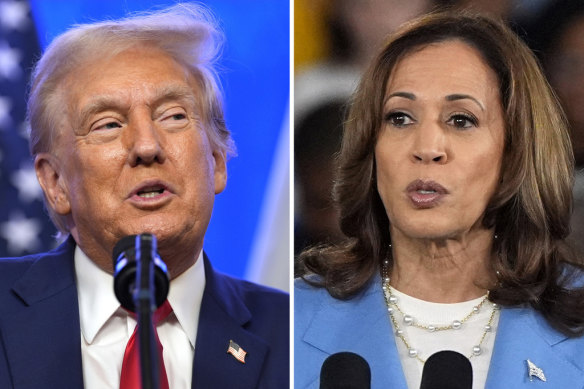This was published 4 months ago
Opinion
The $53 trillion shadow hanging over the US election
Stephen Bartholomeusz
Senior business columnistAt this week’s US presidential debate, there’s likely to be at least some discussion of the big spending plans of the rival candidates. There’ll probably be less focus on their impact on America’s burgeoning government debt and deficits.
With government debt soaring through the $US35 trillion ($52.4 trillion) mark last month (it’s now $US35.32 trillion) and deficits expected to average 6.3 per cent of GDP over the next decade – before adding in Donald Trump or Kamala Harris’ new spending plans – you’d normally expect the sustainability of the government’s finances to be a major talking point in an election campaign, particularly on the Republican side.

Donald Trump and Kamala Harris are both promising to spend big if they get in the White House.Credit: AP
The traditional Republican fiscal conservatives have, however, been sidelined and mute as Trump has unveiled policies that could cost up to four times those of Harris’ own fiscal profligacy.
Trump’s big proposal to reduce government spending? Put Elon Musk at the head of a committee to oversee federal spending, which he says would save “trillions.” Without deep cuts to social security, Medicare and defence spending, however – which Trump has said he won’t touch – there aren’t trillions to be saved.
The Penn Wharton budget model projects that Trump’s tax and spending proposals would increase deficits by more than $US5.8 trillion over the next decade. A similar analysis of Harris’ plans concluded they would add $US1.2 trillion to deficits.
While Trump’s proposals would see all income groups benefit (albeit, as the analysis says, pushing the cost onto future generations), the wealthy would do almost twice as well as low-income groups. Low-income groups would gain much more from Harris’ plans than Trump’s, while companies and the wealthiest Americans would pay more tax.
On taxes, Trump plans to extend the tax cuts for the wealthy and companies he enacted in 2017, which cost $US1.9 trillion, eliminate the taxes seniors pay on social security benefits and eliminate tax on tips. He’d like to lower the corporate tax rate from 21 per cent to 15 per cent.
Harris would allow Trump’s 2017 tax cuts to expire next year but retain the lower rates for households with less than $US400,000 a year of income while raising the rates for companies and wealthier individuals.
She’d expand the child tax credit from $US2000 to as much as $US6000, provide a $US50,000 deduction for the start-up costs of small business, provide a $US25,000 tax credit for first home buyers, abolish taxes on social welfare payments, increase the capitals gains tax rate from 20 per cent to 28 per cent, impose a 4 per cent tax on share buybacks and replicate on a smaller scale, and at about half the cost, Trump’s removal of taxes on tips.

Trump’s promise for a baseline tariff and punitive tariffs on China’s exports is likely to have a negative impact on economic activity.Credit: Bloomberg
The eventual costs of the competing proposals aren’t yet calculable, given that both Trump and Harris have kept rolling out new spending plans. Their impact on debt and deficits, moreover, will depend on whether there are new revenue-raising proposals.
Harris’ approach is straightforward, with increased taxes funding most, but not all, of the measures she’s announced.
Trump believes – despite the evidence of his own term – that lowering taxes further and adding some deregulation will boost growth, increase revenues and lower the ratio of deficits and debts to the size of an enlarged economy. Supply-side economics used to be discredited.
He also thinks that boosting energy production, which is already at record levels, will reduce inflation and add economic growth. West Texas Intermediate crude has recently been trading at three-and-a-half-year lows.
Trump added $US8.4 trillion of government debt ($US4 trillion if pandemic-related spending is excluded) while Biden has added about $US4.35 trillion ($US2.25 trillion excluding pandemic relief).
Trump also has a magic pudding to help fund his promises – a massive new sales tax.
Contrary to the opinions of almost all respected economists, Trump believes that tariffs are a tax on exporting economies. In reality, they are a tax on importers and the consumers of the importing economies. They are a consumption tax.
He plans a 10 per cent baseline tariff on all imports (he’s talked of a tariff double that rate) and a 60 per cent tariff on imports from China and has mused about the prospect of far higher tariffs that might be used to remove America’s income taxes.
Given that revenue from individual and corporate taxes is more than $US3 trillion but the total value of all imports is $US3 trillion, it would require a duty rate of more than 100 per cent and an assumption that there would be no behavioural changes in response for those numbers to add up.
It is apparent that neither Trump nor Harris gives any priority to stabilising America’s debt and the $US1.7 trillion a year net interest bill the Congressional Budget Office sees within a decade even on existing policy settings.
Even without that nonsensical thought bubble, the plan for a baseline tariff and punitive tariffs on China’s exports is likely to have a negative impact on economic activity.
The Peterson Institute for International Economics has modelled the cost of a 10 per cent baseline tariff to the average household at $US1700 a year. At 20 per cent, the impact would be $US2600 a year.
Trump’s tariff plan would add to inflation, create pressure for higher interest rates, reduce investment and employment and increase debt. It would also risk igniting a global trade war, damaging the entire global economy for no US gain.
His plan to round up and place 15 million to 20 million immigrants in mass detention centres and deport them would also impact labour availability and costs, reduce economic activity and add to inflation.
There’s a distinct difference, both to the scale and nature of the competing policies – Trump’s are broadly pro-corporate and involve lower taxes while Harris’ are broadly anti-corporate, and redistributional. Her higher taxes and a range of policies like negotiated lower prices for pharmaceuticals and a crackdown on price “gouging” by companies signal where she sits on the political spectrum.
It is apparent that neither Trump nor Harris give any priority to stabilising America’s debt and the $US1.7 trillion a year net interest bill the Congressional Budget Office sees within a decade even on existing policy settings.
With the exception of Trump’s trade policies, which have obvious implications for the rest of the world, it would be easy to say that the policy promises being made by the candidates and the impact of those promises, if implemented, on America’s debt and deficits are America’s problem.
The importance of America’s economy and financial markets to the rest of the world, however, means that it exports its problems.
If it doesn’t do something about its government finances, interest rates in the US will remain elevated relative to where they might otherwise be to attract the investors needed to fund the government and global growth.
With the IMF having estimated that a 1 percentage point increase in the US 10-year bond rate flows through to 90 basis point rises in advanced economies and a near-total pass-through to emerging market economies, there would also be a very direct cost to other economies and their government and households’ finances.
The Business Briefing newsletter delivers major stories, exclusive coverage and expert opinion. Sign up to get it every weekday morning.